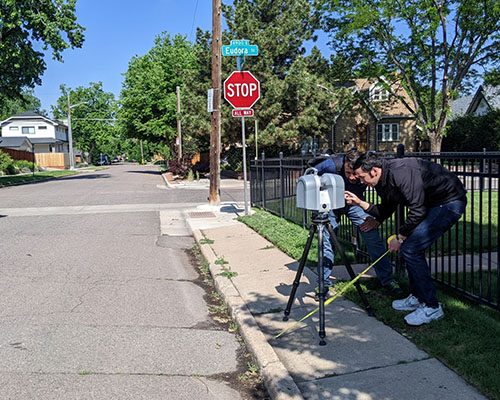Research Reports
Report Details
Abstract
 Despite the ADA’s passage in 1990, non-compliant pedestrian infrastructure remains widespread, often due to the lack of comprehensive pedestrian infrastructure data. Traditional methods of measuring compliance are time consuming, prompting the need for more efficient approaches. This research explores the potential and effectiveness of mobile LiDAR technology in assessing ADA compliance of sidewalks and curb ramps in various scenarios.
Despite the ADA’s passage in 1990, non-compliant pedestrian infrastructure remains widespread, often due to the lack of comprehensive pedestrian infrastructure data. Traditional methods of measuring compliance are time consuming, prompting the need for more efficient approaches. This research explores the potential and effectiveness of mobile LiDAR technology in assessing ADA compliance of sidewalks and curb ramps in various scenarios.
Part 1 evaluates the capabilities of the iPhone 13 Pro’s LiDAR, a low-cost mobile LiDAR technology, against a high-quality Trimble TX8 unit and field measurements. Results suggest that the iPhone’s LiDAR is generally effective at detecting minute ADA compliance issues, although with some variability in curb ramp slope measurements.
Part 2 investigates the impact of obstructions on data quality in detecting ADA compliance of sidewalks and curb ramps, such as might be found when pedestrian infrastructure data are collected from the middle of the street instead of from the sidewalk. Findings suggest significant data gaps due to obstructions like vegetation and parked cars when LiDAR data are collected from streets. Despite these challenges, the study highlights the potential of mobile LiDAR, particularly in unobstructed areas, to improve ADA compliance assessments and enhance accessibility for individuals with disabilities.
How to Cite
Cameron, Christopher, David Todorut, Wesley Marshall, Nicholas Coppola, Chengbo Ai, and Bruce Janson. Pedestrian Infrastructure and ADA Compliance: Leveraging Advances in Spatial Technologies, MPC-24-563. North Dakota State University - Upper Great Plains Transportation Institute, Fargo: Mountain-Plains Consortium, 2024.